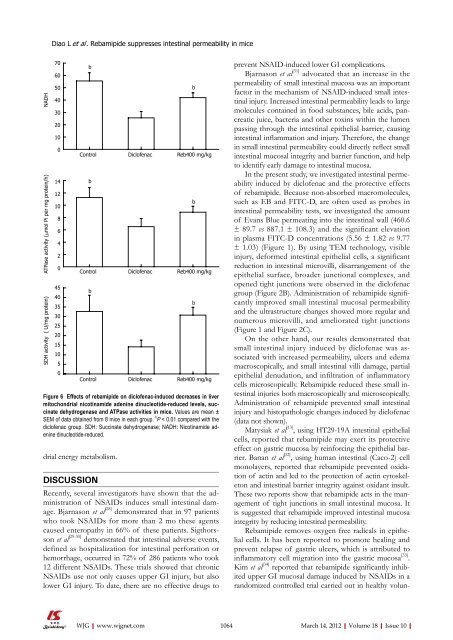10 - World Journal of Gastroenterology
10 - World Journal of Gastroenterology
10 - World Journal of Gastroenterology
Create successful ePaper yourself
Turn your PDF publications into a flip-book with our unique Google optimized e-Paper software.
NADH<br />
ATPase activity (µmol Pi per mg protein/h)<br />
SDH activity ( U/mg protein)<br />
Diao L et al . Rebamipide suppresses intestinal permeability in mice<br />
70<br />
60<br />
50<br />
40<br />
30<br />
20<br />
<strong>10</strong><br />
0<br />
14<br />
12<br />
<strong>10</strong><br />
8<br />
6<br />
4<br />
2<br />
0<br />
45<br />
40<br />
35<br />
30<br />
25<br />
20<br />
15<br />
<strong>10</strong><br />
5<br />
0<br />
drial energy metabolism.<br />
b<br />
DISCUSSION<br />
Control Dicl<strong>of</strong>enac Reb400 mg/kg<br />
b<br />
Control Dicl<strong>of</strong>enac Reb400 mg/kg<br />
b<br />
Control Dicl<strong>of</strong>enac Reb400 mg/kg<br />
Figure 6 Effects <strong>of</strong> rebamipide on dicl<strong>of</strong>enac-induced decreases in liver<br />
mitochondrial nicotinamide adenine dinucleotide-reduced levels, succinate<br />
dehydrogenase and ATPase activities in mice. Values are mean ±<br />
SEM <strong>of</strong> data obtained from 8 mice in each group. b P < 0.01 compared with the<br />
dicl<strong>of</strong>enac group. SDH: Succinate dehydrogenase; NADH: Nicotinamide adenine<br />
dinucleotide-reduced.<br />
Recently, several investigators have shown that the administration<br />
<strong>of</strong> NSAIDs induces small intestinal damage.<br />
Bjarnason et al [28] demonstrated that in 97 patients<br />
who took NSAIDs for more than 2 mo these agents<br />
caused enteropathy in 66% <strong>of</strong> these patients. Sigthorsson<br />
et al [29-30] demonstrated that intestinal adverse events,<br />
defined as hospitalization for intestinal perforation or<br />
hemorrhage, occurred in 72% <strong>of</strong> 286 patients who took<br />
12 different NSAIDs. These trials showed that chronic<br />
NSAIDs use not only causes upper GI injury, but also<br />
lower GI injury. To date, there are no effective drugs to<br />
WJG|www.wjgnet.com<br />
b<br />
b<br />
b<br />
prevent NSAID-induced lower GI complications.<br />
Bjarnason et al [31] advocated that an increase in the<br />
permeability <strong>of</strong> small intestinal mucosa was an important<br />
factor in the mechanism <strong>of</strong> NSAID-induced small intestinal<br />
injury. Increased intestinal permeability leads to large<br />
molecules contained in food substances, bile acids, pancreatic<br />
juice, bacteria and other toxins within the lumen<br />
passing through the intestinal epithelial barrier, causing<br />
intestinal inflammation and injury. Therefore, the change<br />
in small intestinal permeability could directly reflect small<br />
intestinal mucosal integrity and barrier function, and help<br />
to identify early damage to intestinal mucosa.<br />
In the present study, we investigated intestinal permeability<br />
induced by dicl<strong>of</strong>enac and the protective effects<br />
<strong>of</strong> rebamipide. Because non-absorbed macromolecules,<br />
such as EB and FITC-D, are <strong>of</strong>ten used as probes in<br />
intestinal permeability tests, we investigated the amount<br />
<strong>of</strong> Evans Blue permeating into the intestinal wall (460.6<br />
± 89.7 vs 887.1 ± <strong>10</strong>8.3) and the significant elevation<br />
in plasma FITC-D concentrations (5.56 ± 1.82 vs 9.77<br />
± 1.03) (Figure 1). By using TEM technology, visible<br />
injury, deformed intestinal epithelial cells, a significant<br />
reduction in intestinal microvilli, disarrangement <strong>of</strong> the<br />
epithelial surface, broader junctional complexes, and<br />
opened tight junctions were observed in the dicl<strong>of</strong>enac<br />
group (Figure 2B). Administration <strong>of</strong> rebamipide significantly<br />
improved small intestinal mucosal permeability<br />
and the ultrastructure changes showed more regular and<br />
numerous microvilli, and ameliorated tight junctions<br />
(Figure 1 and Figure 2C).<br />
On the other hand, our results demonstrated that<br />
small intestinal injury induced by dicl<strong>of</strong>enac was associated<br />
with increased permeability, ulcers and edema<br />
macroscopically, and small intestinal villi damage, partial<br />
epithelial denudation, and infiltration <strong>of</strong> inflammatory<br />
cells microscopically. Rebamipide reduced these small intestinal<br />
injuries both macroscopically and microscopically.<br />
Administration <strong>of</strong> rebamipide prevented small intestinal<br />
injury and histopathologic changes induced by dicl<strong>of</strong>enac<br />
(data not shown).<br />
Matysiak et al [13] , using HT29-19A intestinal epithelial<br />
cells, reported that rebamipide may exert its protective<br />
effect on gastric mucosa by reinforcing the epithelial barrier.<br />
Banan et al [32] , using human intestinal (Caco-2) cell<br />
monolayers, reported that rebamipide prevented oxidation<br />
<strong>of</strong> actin and led to the protection <strong>of</strong> actin cytoskeleton<br />
and intestinal barrier integrity against oxidant insult.<br />
These two reports show that rebamipide acts in the management<br />
<strong>of</strong> tight junctions in small intestinal mucosa. It<br />
is suggested that rebamipide improved intestinal mucosa<br />
integrity by reducing intestinal permeability.<br />
Rebamipide removes oxygen free radicals in epithelial<br />
cells. It has been reported to promote healing and<br />
prevent relapse <strong>of</strong> gastric ulcers, which is attributed to<br />
inflammatory cell migration into the gastric mucosa [33] .<br />
Kim et al [34] reported that rebamipide significantly inhibited<br />
upper GI mucosal damage induced by NSAIDs in a<br />
randomized controlled trial carried out in healthy volun-<br />
<strong>10</strong>64 March 14, 2012|Volume 18|Issue <strong>10</strong>|

















